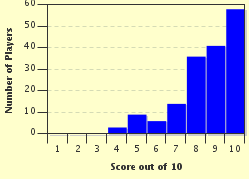Quiz Answer Key and Fun Facts
1. Yasser Arafat, awarded the Nobel Peace Prize in 1994, died suddenly in 2004. This prompted a number of theories as to the cause, including polonium poisoning. Who received a Nobel Prize for Chemistry in 1911 for the discovery of the elements radium and polonium?
2. Who, along with Paul Adrien Maurice Dirac, was awarded the Nobel Prize in Physics 1933 'for the discovery of new productive forms of atomic theory'?
3. Who, along with Francis Crick and Maurice Wilkins, earned a Nobel Prize in 1962 for deducing the three-dimensional double-helix structure of DNA?
4. The photo alludes to the title of a book contributing to this author receiving the 1954 Nobel Literature Prize. Who was the author?
5. What discovery was behind the 1945 Nobel in Physiology or Medicine, which was awarded to Sir Alexander Fleming, Ernst Boris Chain and Sir Howard Walter Florey?
6. Who shared his 1909 Nobel Prize with Karl Ferdinand Braun for 'in recognition of their contributions to the development of wireless telegraphy'?
7. Which birth-marked politician was presented the Nobel Prize for Peace in 1990?
8. Receiving the 1980 Booker Prize for his novel 'Rites of Passage' (first of his 'To the Ends of the Earth' trilogy), which novelist also received the Nobel Prize for Literature in 1983?
9. Which organisation was awarded the Nobel Prize for Peace three times during the 20th century? (Click on the photo for a larger version.)
10. Known for such quotes as: "We must accept finite disappointment, but never lose infinite hope", who was awarded the Nobel Peace Prize in 1964?
Source: Author
suomy
This quiz was reviewed by FunTrivia editor
bloomsby before going online.
Any errors found in FunTrivia content are routinely corrected through our feedback system.


